Business
10 Subscription Based Services Business Owners Need to Try in 2022
Published
3 years agoon

Over the past decade, subscription-based services have taken the business world by storm. Cloud-based infrastructure makes it easier for businesses to start, scale, and succeed. Paying a simple regular fee to use a software or service helps keep all your expenses in order.
Nobody wants to get tangled up in too many subscriptions. And with so many services on the market, it’s easy to end up with more than you need. That’s why we’ve assembled 10 great subscription based services for your business needs.
1) Hive – Subscription based project management tool
Project management is one of the areas where cloud-based tools come most in handy. Real-time collaboration is a great way to keep track of everyone’s work and ensure that it all gets done.
Hive offers just that. On top of task management and time tracking, they offer a variety of views to help each team member visualize their work the way they see fit, whether it’s as a kanban board, Gantt chart, calendar, or table.
There are plenty of great project management tools to choose from, but Hive’s versatility puts it over the top. They offer quick integrations, automations, and even a built-in messaging system.
Pricing: Unlike the rest of these services, Hive only has a single paid subscription plan. They offer three options:
- Solo – Free of charge, for individual users.
- Teams – $12/user/month. Includes shareable forms, an in-app calendar, and Zoom and Slack integrations.
- Enterprise – Bespoke plans for enterprise customers. Include flexible add-ons, heightened security, custom analytics, and dedicated support.
2) Omnisend – Subscription based ecommerce marketing service
Marketing solutions aren’t exactly hard to come by, but what if your company has specific needs? For ecommerce brands, that’s where Omnisend comes in. This SaaS has everything you need to create successful, automated bulk email campaigns and SMS marketing campaigns.
Tools like sign-up forms are geared directly towards ecommerce. They offer integration with all the major platforms, including Shopify, WooCommerce, and dozens more. They also have some pretty extensive analytics tools to help you keep track of your campaigns’ success.
Pricing: Omnisend comes in three tiers:
- Free – $0/mo. Reach up to 250 contacts. 500 emails/mo.
- Standard – Starts at $16/mo (pricing based on contact list size). 6,000 emails/mo.
- Pro – Starts at $59/mo. Unlimited emails. 3,933+ free SMS credits.
3) Identity Guard – Subscription based data theft protection
Identity theft protection services are often geared towards individuals and families. But while security may start at home, your business’ data is just as precious.
If you’re looking for data theft protection for your business, look no further than Identity Guard, an AI-driven subscription based service by AURA. They offer robust data breach protection as well as employee protection plans, all backed by IBM’s iconic Watson AI.
Pricing: Breach protection comes in two plans:
- Value – $36/year per activation code
- Total – $120/year per activation code. Includes bank account and credit monitoring.
Employee benefit plans are custom-built.
4) Zoho CRM – Subscription based CRM platform
Zoho offers a staggering range of cloud-based software solutions, including email, customer service, docs, HR, and much more. But their first, foremost, and perhaps best offering is their customer relationship management (CRM) platform.
Zoho has great customer solutions for businesses big and small. You can micro-manage operations with their detailed analytics, or streamline your process with automated workflows. On top of all that, it’s totally customizable, so you can create your ideal workspace.
Pricing: Zoho’s CRM comes at five tiers:
- Free – $0. Includes up to 3 users, essentials like leads, documents, mobile apps.
- Standard – $14/user/month. Includes automated workflows and custom dashboards.
- Professional – $23/user/month. Includes real-time notifications and inventory management.
- Enterprise – $40/user/month. Includes AI, mobile SDK, advanced customization.
- Ultimate – $52/user/month. Includes advanced BI and highest possible feature limits.
In addition, you can buy Zoho CRM Plus, which combines 8 other Zoho services, for $57/user/month. Bigin, a pipeline-based CRM for small businesses, starts at $7/user/month.
5) HubSpot CMS Hub – Subscription based content management system
Like Zoho, HubSpot offers a wide range of software solutions for businesses, which they call “hubs.” You can buy these hubs individually according to your needs or combine them for discounted bundle pricing.
Their content management system (CMS) is one of their more impressive hubs. It includes handy tools for secure website hosting and building, including a drag-and-drop editor and mobile optimization. On top of building websites, HubSpot makes it easy to scale with multiple plans and performance monitoring.
Pricing: HubSpot CMS Hub comes in four plans:
- Free – $0. Allows for 1 blog and up to 25 web pages. Includes analytics, hosting, SEO, drag-and-drop editor.
- Starter – Starts at $23/mo. Includes 50 web pages, ad management, URL mappings, payment support, reporting dashboards. Removes HubSpot branding from site.
- Professional – Starts at $360/mo. Allows for up to 100 blogs and 10,000 web pages. Includes custom analytics, advanced SEO, dynamic personalization, content staging, video hosting, site tree.
- Enterprise – Starts at $1,200/mo. Includes highest limits on all features, custom objects, site performance monitoring, web apps, sandboxes, permissions.
A 14-day free trial is available. Add-ons such as custom SSL and limit increases can be built into your plan.
6) Penji – Subscription based graphic design service
Content management is one thing, but where do you get the content itself? When it comes to graphic design, Penji offers professional-quality designs on a subscription basis.
With Penji’s unlimited model, you can get as many designs as you need. Their plans cover everything from logos to social media graphics. They even design websites and apps. With a global team of full-time designers, they deliver quality designs in a matter of days.
Pricing: Penji offers three plans:
- Pro – $499/mo. Includes unlimited graphic design, illustrations, logos and branding.
- Team – $699/mo. Includes unlimited web designs, app designs, presentations, and animated graphics.
- Daytime – $999/mo. Includes USA daytime designers, same-day turnaround, and a dedicated art director.
All plans come with a 30-day money back guarantee.
7) Rippling – Subscription based HR and IT cloud service
This enterprise software solution is one of the best options out there for payroll maintenance, but it’s got much more than that. It combines workflow automation with HR and IT tools, helping enterprises streamline their employer-to-employee processes.
If you’ve been making use of this list, you’ll be especially happy to hear about Rippling’s app management. You can set up, manage, and disable employee apps in one simple place, ensuring that you’re using everything you need and nothing extra.
Pricing: Unfortunately, Rippling doesn’t offer transparent pricing on their site. Because they cater to enterprise customers, they offer quotes based on businesses’ precise needs. At the very least, their core platform costs $35/mo, with an additional $8/user/mo for payroll services.
8) Moz Pro – Subscription based SEO tool
Moz was founded as SEOmoz in 2004 as a site for some of the world’s earliest SEO experts to share their research. Basically, they wrote the book on SEO.
Moz Pro isn’t the cheapest option for SEO on the market, but it uses its history of experience to its advantage. They offer robust, eminently useful data to give your business the search engine boost it needs, crawling your site to precisely pinpoint issues.
Pricing: Moz Pro offers four plans:
- Standard – Starts at $79/mo. Includes 3 campaigns, 300 keyword rankings, 60 tracked URLs, 100k page crawls per week.
- Medium – Starts at $143/mo. Includes 10 campaigns, 1,500 keyword rankings, 200 tracked URLs, 500k page crawls per week.
- Large – Starts at $239/mo. Includes 25 campaigns, 3,000 keyword rankings, 500 tracked URLs, 1.25 million page crawls per week.
- Premium – Starts at $479/mo. Includes 50 campaigns, 4,500 keyword rankings, 1,000 tracked URLs, 2 million page crawls per week.
9) Tableau – Subscription based business intelligence service
You can have all the fancy subscription based software in the world, but it won’t get you anywhere if you’re not paying attention to what works. Tableau is a leader in business intelligence (BI) and analytics. They offer a robust array of digestible data to help your business work smarter.
Tableau is trusted by customers ranging from Whole Foods to Pfizer, Nissan to Charles Schwab. Powered by Salesforce, they also offer integrations with SQL, AWS, and dozens of other cloud services.
Pricing: Tableau offers three cloud-based plans for teams:
- Viewer – $15/user/mo.
- Explorer – $42/user/mo.
- Creator – $70/user/mo.
They also offer server-based plans (on-premise or public cloud), a Creator plan for individuals, and embedded analytics.
10) Bit.ai – Subscription based service for workplace collaboration
The final piece of the puzzle that brings your whole business infrastructure together: collaboration. Plenty of cloud-based offerings include collaboration tools, and many businesses use free tools like Slack and Google Docs to power their communication.
Bit.ai combines all these features and more. Think of it like a document editor that’s also a content manager. It lets businesses share, create, and keep track of the content they put out, all with robust communication. They also integrate easily with tools like Tableau, OneDrive, Google Suite, Miro, Trello, Facebook, and more.
Pricing: Bit.ai offers three plans:
- Free – $0. Allows for up to 5 members, 50 documents, 1GB storage. Includes content library, integrations, collaboration tools.
- Pro – $8/member/month. Allows for unlimited members, unlimited documents, 500GB storage. Includes export, bulk import, version history.
- Business – $15/member/month. Allows for unlimited storage. Includes trackable documents, priority support, engagement analytics, guest access.
Bit.ai also offers custom plans for enterprise customers.
You may like
Business
Top 10 Best Places to Buy a Mid Century Modern Office Chair
Published
2 days agoon
July 4, 2025
What was once old is new again: mid century modern is back in style. From architecture to furniture, the postwar look is in, and the hype extends all the way to office chairs.
Do you need a mid century modern office chair in your life? If so, there’s plenty to choose from. Your office chair should be tailored to your style, whether you like luxury, utility, or something in between.
That’s why we’ve put together our 10 favorite places to find your ideal mid century modern office chair.
What is mid century modern design?
After World War II, spirits were high in the US, and new technology was taking the country by storm. Mid century modern refers to the design concepts that came about during this time.
As opposed to the frilly, ornate designs of classical furnishings, mid century modern designs are angular, material, and functional. Wood is a common design element, especially teak. Mid century modern furniture may also have materials like glass, vinyl, and metal. Designs are simple and geometric, with bold accent colors to make them pop.
The mid century modern aesthetic never really went away, but it’s made a noted comeback in recent years. Some have chalked it up to Boomer and Gen X nostalgia, others point to mid-century-set shows like Mad Men and The Marvelous Mrs. Maisel.
Why should I buy a mid century modern office chair?
Mid century modern is the perfect fusion of style and utility. If you want to cultivate an office space that commands respect without being ostentatious, mid century modern is the style for you.
When it comes to office chairs, an MCM one is often made with sturdy wood and vinyl. They combine the ergonomics of a modern office chair with old-fashioned grace.
If you’re concerned with utility and utility only, a more bog-standard office chair may suit you. But a mid century modern office chair is great for someone who wants to wow colleagues with a mature, thoughtful business space.
Where can I get a mid century modern office chair?
1) Wayfair
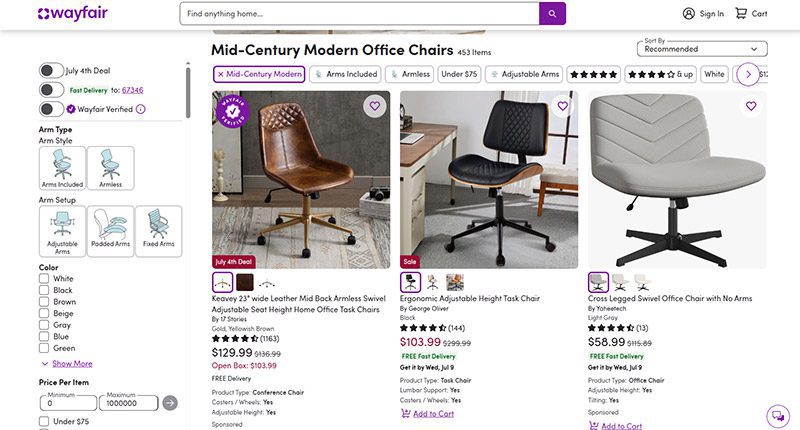
When it comes to furniture, Wayfair offers the best of both worlds. Their goods, including their mid century modern office chairs, are stylish and affordable. You can get a sturdy task chair for less than $100 or a more distinguished seat for less than $350.
MCM office chair examples: Dovray ($126), Bradford ($139), Lithonia ($133)
2) France & Son

Wayfair’s chairs are affordable, but France & Son is the perfect option for luxury shoppers. Their mid century modern office chairs are robust and sleekly designed. If you dress to impress and enjoy the finer things in life, these are the chairs for you.
MCM office chair example: Brooks ($695)
3) Houzz

Started as a community for people to share home decor tips, Houzz has become a great ecommerce platform for finding stylish furniture. They’re more known for home decor than desk chairs, but they have plenty of great, affordable finds if you know where to look.
MCM office chair examples: Arvilla ($173), Rathburn ($259)
4) Laura Davidson

The Laura Davidson collection offers a fairly limited selection of classic office furniture. Still, there’s a reason they’re trusted by big-wigs like Apple, Disney, and Salesforce. Their chairs are sturdy and beautifully designed, reimagining classic Eames and Knoll designs.
MCM office chair examples: Rockefeller ($275), SOHO II Soft Pad ($450)
5) Icons of Manhattan
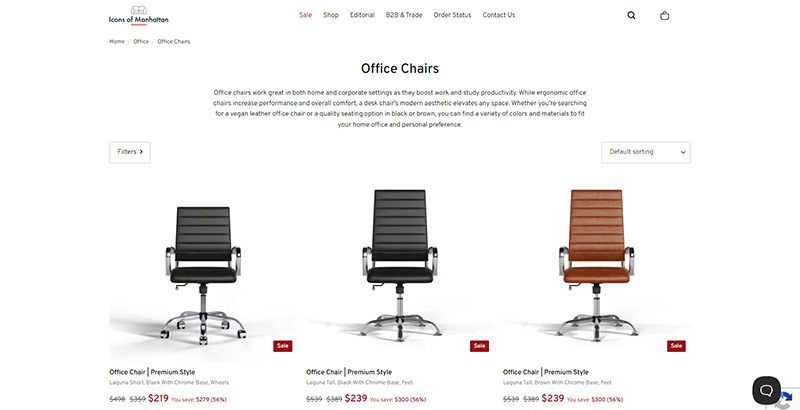
Icons of Manhattan has a simple philosophy: do one thing, and do it right. Their office chairs are handcrafted from premium materials and tailored to a mid-century modern style. If you want that Mad Men energy in your office (hopefully with a lot less angst), these are the chairs for you.
MCM office chair example: Ribbed Medium ($219)
6) Amazon
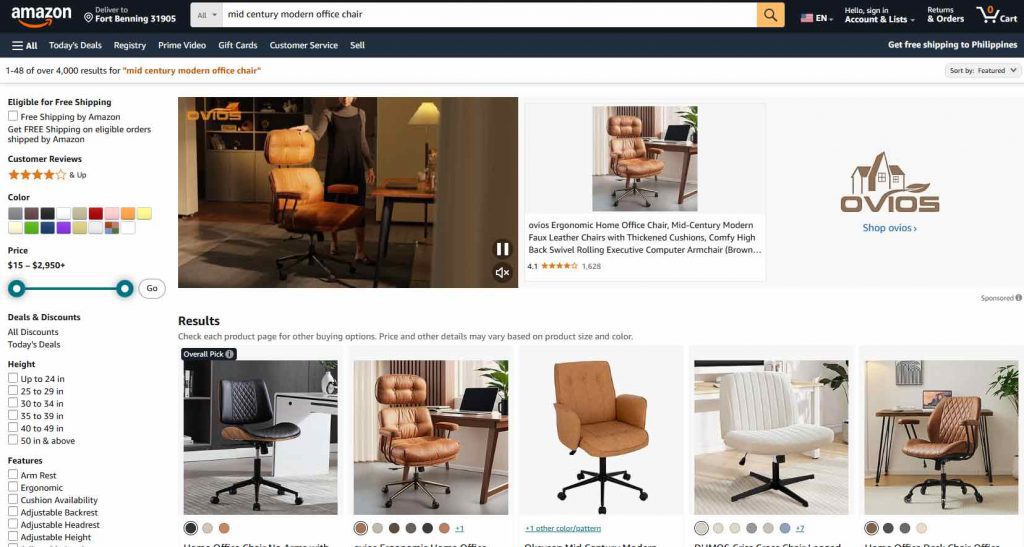
Yes, the internet’s premier shopping destination has a robust collection of mid century modern office chairs. Like with most products, their selection of seats is vast and can be hit or miss. Still, they’ve got stunning chairs available for any style, whether you care about comfort, class, or ergonomics.
MCM office chair examples: IDS Home Modern ($219), Art Leon MCM Swivel ($139)
7) AllModern

AllModern’s collection of desk chairs and other furniture truly embodies the mid century modern spirit. Their work is tight, angular, and functional above all. They’re part of the Wayfair family and they traffic in a number of modern styles, but their sleek chairs are perfect for any mid century modern space.
MCM office chair examples: Frederick ($229), Kealey ($349)
8) Overstock
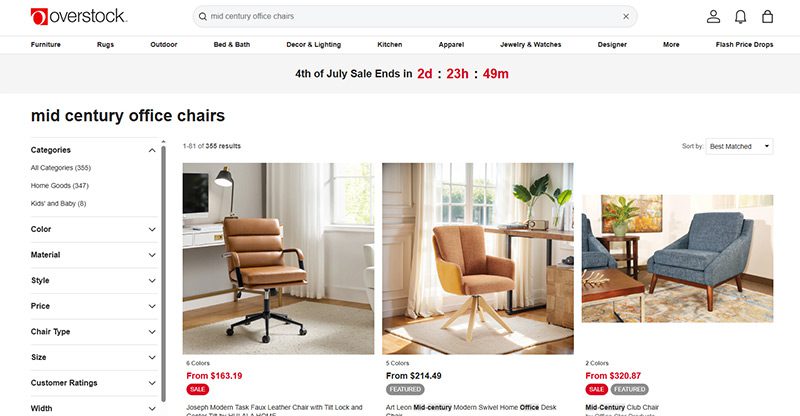
Overstock is known as a one-stop shop for quality home goods at sub-wholesale prices. If you want a spiffy mid century modern office chair that won’t break the bank, they’re the first place to look. While they’re somewhat less reliable than the more upscale platforms on this list, their selection is massive.
MCM office chair example: Joseph Modern ($163)
9) Walmart
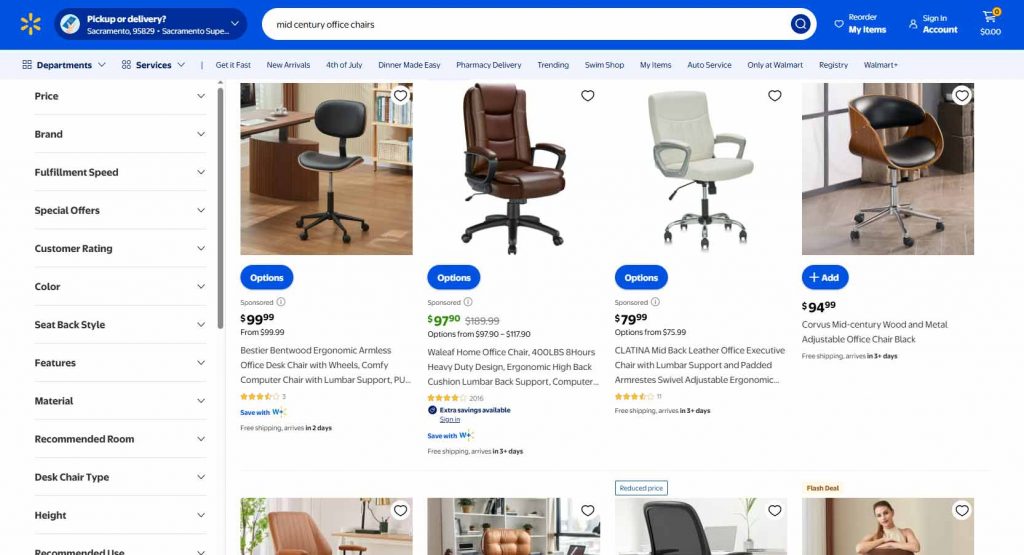
Hayneedle’s selection of mid-century modern office chairs falls somewhere between the minimal Laura Davidson and the endless Amazon catalog. Their array of mid-century designs is affordable and versatile, with chairs that match almost any style. While they may be part of the Walmart family, these chairs are anything but second-rate.
MCM office chair example: Waleaf ($97)
10) Target

Why splurge when you can save? As usual, Target is a hidden gem, offering a sturdy selection of mid century modern office chairs for some of the cheapest prices out there. Many of the chairs they offer are from the same designers as these other stores—Christopher Knight, LumiSource, Armen Living, etc.—at reduced prices.
MCM office chair example: Lombardi ($136)

A quality payroll service is one of the most invaluable tools any entrepreneur can have. Whether you’re a small business owner or an HR manager, paying your employees on time is crucial. This makes choosing a service even more weighty, after all, it is a heavy administrative burden. The good thing is, you can outsource this duty to an online payroll processor.
According to statistics, 49% of workers begin a new job search after just two paycheck errors, and with 65% of workers living paycheck to paycheck, it’s more important than ever to ensure an efficient, effective payroll process.
These services can save you precious time and mitigate potential issues. To make it easy for you to choose, we listed the best online payroll services for 2025.
Top 5 Online Payroll Services
Gusto
Gusto is a great option for both new and experienced payroll administrators, boasting an incredibly clean user interface and a first-rate payroll setup. Gusto lets you manage your employee’s time off (vacation and sick pay), company health insurance, and worker’s comp. Gusto offers excellent mobile access, too. This allows employees to manage aspects of their Gusto profiles, view payday insights, and access Gusto Wallet financial tools.
Gusto offers four tiers of membership, the most affordable of which is the Contractor’s Only plan, which offers unlimited U.S.-based and global contractor payments, supporting more than 100 countries, plus 1099 creation and filing at a rate of $6 per person per month with no base price.
The other three are Simple, Plus, and Premium. Here’s a deeper look into each plan:
Simple
Price:
$40/mo + $6/mo per person
Plan details:
- Full-service single-state payroll including W-2s and 1099s
- Employee profiles and self-service
- Basic hiring and onboarding tools
- Gusto-brokered health insurance administration
- Employee financial benefits
- Payroll and time-off reports
- Custom admin permissions
- Integrations for accounting, time tracking, expense management, and more
Plus
Price:
$80/mo + $12/mo per person
Plan details:
(All Simple plan features +)
- Full-service multi-state payroll including W-2s and 1099s
- Next-day direct deposit
- Advanced hiring and onboarding tools
- PTO management and policies
- Time tracking and project tracking
- Workforce costing and custom reports
- Team management tools
- Full support
Premium
Price:
Bespoke pricing, reach out for a personalized quote
Plan details:
(All Plus plan features +)
- HR Resource Center
- Compliance alerts
- Access to certified HR experts
- Full-service payroll migration and account setup
- Health insurance broker integration
- R&D tax credit discount
- Waived fees and exclusive pricing
- Performance reviews
- Employee surveys and insights
- Dedicated support
QuickBooks Online Payroll
Founded in 1983, Intuit is a California-based financial software company. Since its inception, Intuit has developed into one of the best-known providers of accounting software. Their online payroll service, QuickBooks, includes the essential features you need to run payroll.
QuickBooks offers three tiers of membership. The least expensive membership covers basic accounting features, such as invoices. For more features, check out the Essentials and Plus memberships. Each plan’s features are as follows:
QuickBooks Simple Start (2025)
- Price: $38/month for 1 user
- Best for: Freelancers and small teams with basic payroll needs
Features:
- Automated bookkeeping
- 5 free ACH bank transfers/mo for bills
QuickBooks Essentials (2025)
- Price: $75/month for 3 users
- Best for: Small businesses needing deeper financial tracking
Features:
- Includes all Simple Start features, plus:
- Recurring invoices
QuickBooks Plus (2025)
- Price: $115/month for 5 users
- Best for: Growing businesses with HR and compliance needs
Features:
- Includes all Essentials features, plus:
- AI-powered profit & loss insights
- Anomaly detection and resolution
- Budgeting
QuickBooks Advanced (2025)
- Price: $275/month for 25 users
- Best for: Established businesses with HR and compliance needs
Features:
- Includes all Plus features, plus:
- Custom user management and permissions
- Custom report builder
- Data sync with Excel
- Revenue recognition
- Forecasting
OnPay
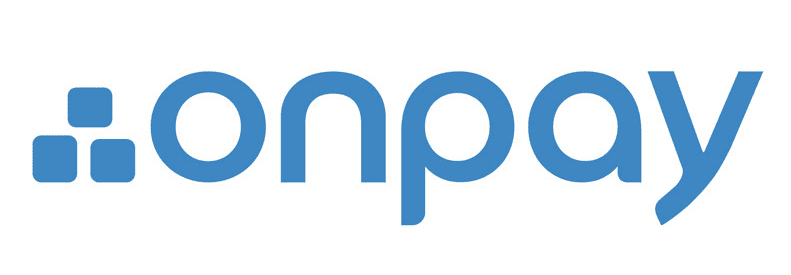
OnPay is a cloud-based full-service payroll processing system capable of running payroll according to a preset schedule, automatically disbursing wages, and calculating and withholding taxes.
OnPay can sync up with several other software your team is already using, making it easy to integrate the service into your team’s system. Another benefit of OnPays model is the simple, transparent pricing structure. No tiers; just one base rate.
Pricing:
$49/mo + $6/mo per employee
SurePayroll

SurePayroll’s award-winning service supports W-2 employees and 1099 contractors. Additionally, it handles 401(k) deductions and manages flexible spending accounts (FSA) and health savings accounts (HSA).
SurePayroll also offers a mobile app— available on both Apple and Android devices.
SurePayroll offers live support through its United States-based support team through chat, email, or phone.
Small Business Payroll
- Price: No Tax Filing: $20/month + $4 per employee, Full Service: $29/month + $7 per employee
- Best for: Small businesses and startups
Features:
- We file and deposit your federal and state taxes!
- Run payroll in 3 simple steps
- Schedule payroll to run automatically
- Unlimited payroll runs and free 2-day direct deposit
- Reports and pay stubs are available online 24/7
- Supports W-2 employees and 1099 contractors
Nanny & Household Payroll
- Price: Full-Service Household, $39/month, includes 1 employee, $10 per additional employee
Best for: Homeowners
Features:
- Signature-ready Schedule H
- We file & deposit your federal and state taxes!
- Run payroll in 3 simple steps
- Schedule payroll to run automatically
- Unlimited payroll runs and free 2-day direct deposit
- Reports & paystubs available online 24/7
- Supports W-2 employees & 1099 contractors
Be sure to choose a payroll service that works for your business, and provides you with the peace of mind that comes with a reliable bookkeeping system. Your employees will thank you.

Merck is currently in talks to acquire Seagen, a biotech company. The Wall Street Journal reports that the transaction is valued at $40 billion. And what happens if Merck acquires Seagen, and how would this acquisition benefit cancer research and treatment? Read more about the Merck Seagen buyout here.
Merck Seagen Buyout
Merck and Seagen are still deciding on their share prices. So far, talks have yet to reach an agreement on $200 per share. Both companies want to settle and finalize their deals before Merck announces its quarterly earnings on July 28. At the time of writing, Seagen’s stock was at $176.19.
With an estimated market value of $235 billion, Merck is looking to expand its presence in the cancer treatment space. The Merck Seagen Buyout could play a major role in that strategy. Since Seagen specializes in targeted cancer therapies, the acquisition would give Merck access to a broader range of oncology products.
Shareholder reactions to the new deal are overwhelmingly positive, and the stocks have been up since talks about the deal have been made public.
But this is not the first time that Merck and Seagen have made the news. Back in 2020, they collaborated because of cancer treatments. Seagen has a drug conjugate (ladiratuzumab vedotin) which would be used in conjunction with Merck’s Keytruda.
Merck reveals that Keytruda is its highest-selling product. It’s immunotherapy for cancer.
And this deal could help Merck offset the possibility of reduced sales because it will lose patent protection in 2028.
As promising as this deal is, there could be scrutiny from antitrust officials since there might be a litigation case from the Federal Trade Commission or Justice Department.
The Seagen buyout isn’t the only deal Merck has made recently. They’ve been busy closing another deal, but with Orion too.
Seagen
As a cancer biotech company, Seagen has therapies to ensure that patients benefit from the treatment and reduce any adverse side effects. Their treatments involve the therapy attacking tumors with toxins.
Merck partnering with Seagen isn’t a bad idea considering that Seagen made $1.4 billion in sales in 2021, most of it coming from Adcetris and Padcev (a treatment for urothelial cancers).
Merck-Orion Deal
In the middle of the Merck Seagen Buyout, Merck has recently partnered with Orion for the ODM-208 and other drugs. These drugs are related to the production of steroids. Orion found how it can combat hormone-dependent cancers and further developed this inhibitor.
Their deal includes that they should develop ODM-208 and promote it to the public together. And Orion will receive a $290 million payment from Merck.
Although they’re co-developing and marketing the new inhibitor, Orion will oversee the manufacturing side.
Co-developing the ODM-208 can help Merck with its current research and treatments for prostate cancer. President and CEO of Orion, Timo Lappalainen, says that this partnership will benefit Merck’s goals of treating cancer worldwide.
Other Ventures: Merck’s Role in the Pandemic
You may have heard about COVID-19 pills, which are a form of treatment for those diagnosed with mild to moderate COVID-19. Merck introduced an antiviral COVID-19 pill to the public. The name: Molnupiravir.
The COVID-19 pill is not a replacement for a vaccination. Instead, it stops the replication of the COVID-19 genetic code and keeps the patient out of the hospital. Not yet FDA-approved, Molnupiravir has been authorized for emergency use since December 23, 2021.
And for other stories, read more here at Owner’s Mag!

Top 12 Uses for The Metaverse That Will Change Your Life

Top 10 Best Places to Buy a Mid Century Modern Office Chair

The Best Online Payroll Services [Updated for 2025]

Top 10 Small Business Organization Tools for 2025

8 Best Equipment for YouTube Every Content Creator Needs

Merck Seagen Buyout: What to Know About the Deal

The Rise and Fall of Juul: Once a Silicon Valley Darling, Now Banned by FDA

What’s the Deal With Elomir? Is Axis Klarity a Scam?

Why Having an Advisory Board Could Make or Break Your Startup

Top 10 Best Places to Buy a Mid Century Modern Office Chair

Loom Review: Features, Use Cases, and How It Stacks Up Against Zoom

8 Best Equipment for YouTube Every Content Creator Needs

The Rise and Fall of Juul: Once a Silicon Valley Darling, Now Banned by FDA

The Best Ways to Recession Proof Your Business
Trending
- Business2 days ago
Top 10 Best Places to Buy a Mid Century Modern Office Chair
- Technology3 days ago
8 Best Equipment for YouTube Every Content Creator Needs
- Technology3 days ago
Top 10 Small Business Organization Tools for 2025
- Technology1 day ago
Top 12 Uses for The Metaverse That Will Change Your Life
- Business2 days ago
The Best Online Payroll Services [Updated for 2025]





